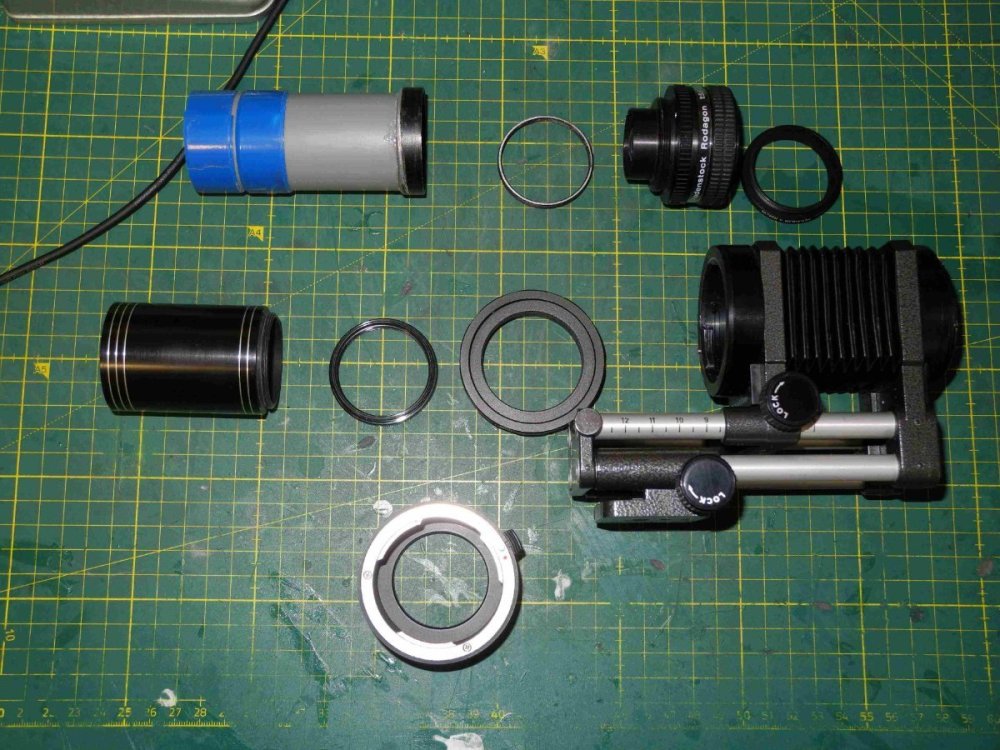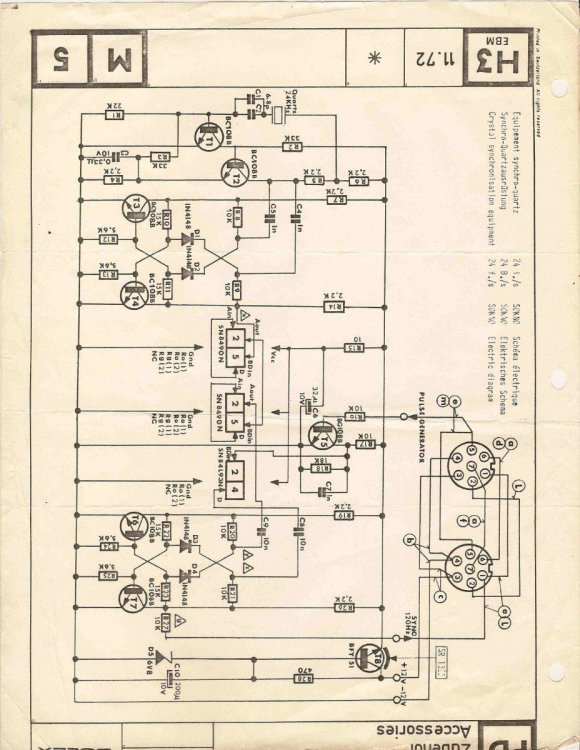
Dr. Thomas Faehrenkemper
Basic Member-
Posts
40 -
Joined
-
Last visited
Everything posted by Dr. Thomas Faehrenkemper
-
Super 8...🙂
-
Here is some Fomapan R100 footage (Super 😎 home processed in Dokumol 1+7 with KSCN 5g/l and KJ 50 mg/l for FD, 8 min , 68 F. Scanned with my homemade frame scanner (modified Noris projector).
-
It's actually quite simple, you take a DC-DC step-up converter, a USB-C connection, an RCA cable with a 3.5 mm plug and an LED with a 270 Ohm series resistor an assemble iti n a small housing, then adjust the charging voltage with the blue spindle trimmer so that the charging current is around 1/10 C, depending on the battery (or more, for shorter charging times) and you're done! So for a small 400 mAh battery from 2/3 AAA cells then 40 mA. Measured with an amp meter. If you don't have a charging container, you can also charge directly in the camera. The step-up converter is available from Amazon or Ebay as a small ready-made component, as are all the other parts, of course. Or in an electronics store, if you have one around the corner. This works for the 2008, which is operated with 4 cells (4.8V) and of course also for the 4008 and R16, which have 6 cells and 7.2 V respectively.
-
Now, first of all the lens barrel diameter on the Siemens 2000 is 42,5 mm, I took a 40 mm plastic tube and some tape to adapt it. It fits properly now. The length about 80 mm. This is impotant to get a proper focus, the extension towards the camera gives the magnification. An old M42x1mm lid with a central aperture of 32 mm was glued on the plastic tube, then follows a stepdown ring M 42x1 mm to M39x1 mm for the lens thread. Would be nice to get this machined. The lens is a Rodagon 5,6 80 mm. Fortunately, a reverse ring M40,5x 0,5 to M 39x1 (RAF Camera Austria) fits the lens, the follows an M39x1 extension tube of 60 mm (Leica thread) to a stepup ring M39x1 to a T2 thread. A further adaptor from a Leica R mount tt T2 is necessary, then the bellows and finally a Leica R to Fuji XF adaptor. That all sounds complicated, most important is the legth of the plastic tube and the extension between the frot tread of the lens to the XF adaptor, about 15cm. Then you get the magnification needed for the APS-C frame. It takes some patience and finally you must try it out to achieve a sharp image. The number of different rings comes from the lot of stuff I still had in my craft box. As Mark Dunn mentioned the bellows facilitate focussing, but most decisive is the plastic tube. Once you have the lens mounted the extension for the proper size can be made by different means.
-
The principle was: simple, safe, short. No microcontroller, no software, easy to build and best image quality. The drive is a stepper motor NEMA 17, with a readily available motor controller, the lamp is a DZYDZR Mini 1W 5 V USB LED lamp, the currency is delivered by an old transformer and an rectifier, and the 5 V for the lamp by a step down circuit, also readily available. Finally, my camera, a Fuji XT4 is released by a reed contact. The lens is a Rodagon 80mm 5,6 in retro positon. Here is the link to my thread (in German): https://www.filmvorfuehrer.de/topic/40973-simple-safe-short-teil-2-mein-weg-zum-16mm-framescanner/ Her you can the result:
-
Inside a 24fps Crystal Controller (Photos)
Dr. Thomas Faehrenkemper replied to Kamran Pakseresht's topic in Bolex
-
Nice footage and congratulations to your new R16. I have 3 of it, and all are working flawlessly. The finder is bright and clear, much nicer than a Bolex that I own as well, and the motorized film transport is very comfortable to work with. The spring driven Bolex typically stops at the decisive moment... To calibrate the meter without the ASA ring just take an external one, set 1/60 for 25 fps transmit the f stop of your hand held meter to the T-scale of your lens and adjust the needle in the finder turning the ASA dial so that the needle in the finder is in the middle of the reference cross. VOILA. Wittner Cinetec in Germany offers the ring as a spare part, but the price is astronomic.
-
Replacing Warped Beaulieu R-16 Turret Plate
Dr. Thomas Faehrenkemper replied to NateMcDaniel's topic in 16mm
Simple thing. On the back of the turret plate, you normally find the adäquate thickness scratched in, 4+- mm. When you order a new one, justt tell the technician the thickness of the old one. -
Beaulieu R16 Recell Camera Drive Inoperative
Dr. Thomas Faehrenkemper replied to Matt Boese's topic in 16mm
The sync axis is covered by a little srew in lid down on the right side. To get to the motor fuse, you must remove the lid unter the speed galva, 5 tiny screws. The fuse is just a very thin wire that melts. Renew it and see if the camera works then. -
Beaulieu R16 Schematics / Service Manual
Dr. Thomas Faehrenkemper replied to Hayden Smith's topic in 16mm
Here is a link for a download. https://van-eck.net/en/product/beaulieu_r16_technical_documentation_spare_parts_and_service_manual-_languages-_english/ -
Fomapan R100 Home Developing Question
Dr. Thomas Faehrenkemper replied to Christian Flemm's topic in Film Stocks & Processing
Try this, i Have been working for a long time to get perfect results, and it works. Umkehrentwicklung des Fomapan R100 in Dokumol 1+7, aktualisiert 18.05.23.docx -
Beaulieu R16 repair manual
Dr. Thomas Faehrenkemper replied to Dr. Thomas Faehrenkemper's topic in 16mm
Dear Tyler, have a look at "www.learncamerarepair.com" , youl will find the manual there, first in Finnish, second part in English. -
Beaulieu R16 repair manual
Dr. Thomas Faehrenkemper replied to Dr. Thomas Faehrenkemper's topic in 16mm
Björn Andersson in Sweden is the technician with the best reputation for Beaulieu. Björn Andersson, Filmkonsult Svebaco KB Vidholmsbackarna 54 165 72 Hasselby +46-8381074 Weltweiter Beaulieu-Spezialist Schweden Kamerareparatur, Reparatur -
You can find and download the manual here at the German "Filmvorführerforum", look at jacquestati... https://www.filmvorfuehrer.de/topic/27399-beaulieu-2016-quartz/#comment-298346
-
Beaulieu R16 Schematics / Service Manual
Dr. Thomas Faehrenkemper replied to Hayden Smith's topic in 16mm
Dear Sam, need your email adress for mailing the manual via "Wesendit". Thomas -
Beaulieu s2008 Cleaning question (mirror/glass)
Dr. Thomas Faehrenkemper replied to Andrew Law's topic in Super-8
It's the filter. Remove the lens, take a cotton wool tip or so, and remove the filter by gently pushing it out from the inside to the ountsinde (c-mount thread). There are two, one KR15 and a clear one, they are moved by the filter key in the grip. You can remove the c-mount thread plate before, peel off the black cover and remove the 4 screws. Is easier then. Afterwards for you need a KR15 filter for Tungsten film at daylight. May be, the lengs must bei collmated after the procedure, but in most cases it is fine. -
Be careful, ONLY 4,8 V Batteries may be used!!
-
Achten Sie darauf, dass die Kamera nur 4,8 V Batterien benötigt!
-
De rien!
-
It must have the gear for the aperture and the zoom. Will work then.





